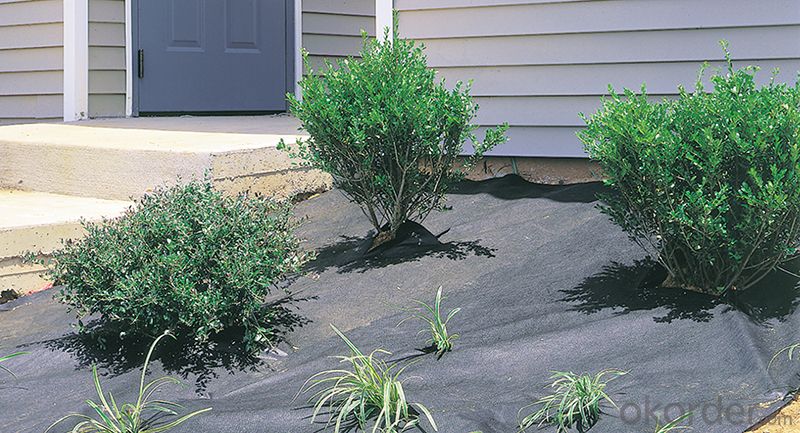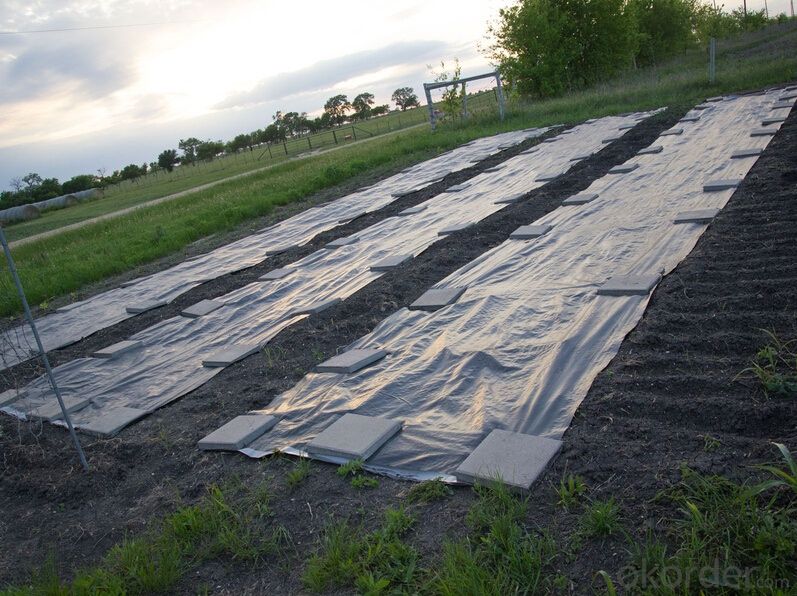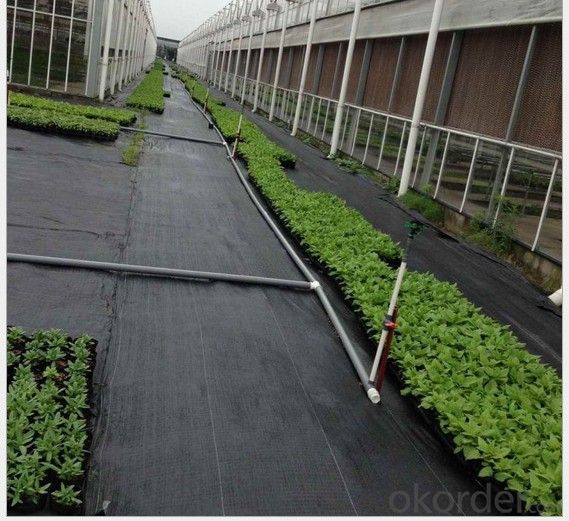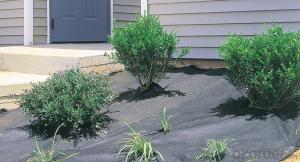Wooden Silt Fence/ Polypropylene Woven Fabric
- Loading Port:
- China main port
- Payment Terms:
- TT OR LC
- Min Order Qty:
- 5000 m²
- Supply Capability:
- 100000 m²/month
OKorder Service Pledge
OKorder Financial Service
You Might Also Like
Product Description:
1.Silt Fence Description:
Spunbonded PP non woven weed control mat is made of environmentally friendly raw materials, pp spunbond nonwoven fabric. It used to prevent the growth of weed, without the use of potentially dangerous chemical sprays or labor intensive hoeing. Once installed, weed mat will continue providing protection for years without maintenance.
They are permeable fabrics, which allow air, water and nutrients to pass through, and designed to block out the sun to reduce photosynthesis and stop weed growth.



2.Weed Barrier Fabric Functions and Features:
1)Excellent weed control
2)Excellent UV resistance
3)Moisture,fertilizers,air reach plants to allow for healthy soil
4)Good water and air permeability
5)Exceptional toughness and strength
6)Durable,tear-resistant,anti-rot and anti-mildew
7)Light weight,easy to install,follows natural ground contours
8)Ideal for use in landscaped beds,under decks and walkways
9)Fashionable design,high quality,competitive price
10)Long service life
3. Weed Barrier Fabric Usage:
1.Prevent leakage disposal in landfill or waste water or waste dregs disposing field.
2.River bank ,lake dam ,mine remainings ,resevoir ,tunnel ,liquid storage pool(pit ,mine)
3.Preventing leakage in subway ,basement ,tunnel ,hole .
4.Anti-salt leakage in roadbed and other ground sill.
5.The plane direction laying of dam ,the vertical direction laying for ground sill.used in the construction fence and waste material field.
6.Used in ground sill of road ,highway ,railway and waterproof layer of welling clay and wet collapsed loess.
7.Preventing leakage on rooftop.
4. FAQ:
Q1: What is your minimum order quantity?
A:The minimum order quantity is 5000 ,but it is negotiable.
Q2:What is your payment terms?
A: T/T,Western Union,Paypal,L/C...
Q3:What is your delivery time?
A:Production time usually costs 2-20 days.
Waiting to cooperate with you!
- Q:What are the advantages of using geotextiles in shoreline stabilization?
- There are several advantages of using geotextiles in shoreline stabilization. Firstly, geotextiles act as a barrier that prevents erosion and protects the shoreline from wave action. They provide stability to the soil by providing reinforcement and preventing the loss of sediment. Additionally, geotextiles allow for the filtration of water, which helps to maintain water quality and prevent the buildup of sediment. Furthermore, geotextiles are cost-effective compared to traditional methods of shoreline stabilization, as they require less maintenance and can be easily installed. Overall, geotextiles offer a sustainable and environmentally friendly solution for shoreline stabilization.
- Q:Can the tunnel longitudinal drains be wrapped with geotextiles and wrapped with a waterproof board?
- With geotextile wrapped drainage pipe is generally played the role of seepage drainage, do not need waterproof board (you said the waterproof board should be geomembrane it) Chong Hong geotextile material manufacturers
- Q:What are the factors to consider when selecting geotextiles for embankment stabilization?
- When selecting geotextiles for embankment stabilization, there are several important factors to consider. These include the strength and durability of the geotextile, its filtration and drainage properties, its compatibility with the soil and other materials, and its ability to withstand environmental conditions such as UV exposure and chemical exposure. Additionally, factors such as cost, installation requirements, and project-specific needs should also be taken into account.
- Q:The vertical permeability coefficient of 400 g per square filament geotextile is generally how much
- I know that 400g short wire geotextile vertical permeability coefficient is ≥ 57.5cm / s
- Q:Can geotextiles be used in mining and tailings management applications?
- Yes, geotextiles can be used in mining and tailings management applications. Geotextiles are often utilized to separate and reinforce soil layers, provide drainage, and prevent erosion in mining and tailings management. They help in controlling water flow, stabilizing slopes, and enhancing the overall performance and sustainability of these applications.
- Q:Can geotextiles be used in riverbank stabilization projects?
- Yes, geotextiles can be used in riverbank stabilization projects. Geotextiles are often employed to reinforce and protect soil in various civil engineering applications, including riverbank stabilization. They can help prevent erosion, control sediment movement, and provide stability to riverbanks by improving soil strength and drainage.
- Q:Can geotextiles be used in land reclamation projects?
- Yes, geotextiles can be used in land reclamation projects. Geotextiles are often employed to stabilize soil and prevent erosion during the reclamation process. They provide a barrier that separates different soil layers, allowing water to drain while preventing the loss of fine particles. Additionally, geotextiles can reinforce weak soils, increase their load-bearing capacity, and promote vegetation growth, making them a valuable tool in land reclamation projects.
- Q:What are the different geotextile installation techniques for landfill applications?
- There are several geotextile installation techniques commonly used for landfill applications. These include the direct placement method, the trench method, the soil cover method, and the liner method. The direct placement method involves placing the geotextile directly on the subgrade or waste material, while the trench method involves placing the geotextile in a trench and then covering it with soil. The soil cover method involves placing the geotextile on top of the waste material and then covering it with a layer of soil. The liner method involves placing the geotextile on top of a geomembrane liner to provide additional protection and support. Each method has its own advantages and considerations depending on the specific requirements of the landfill site.
- Q:Geotextile how the weight of how many meters
- Cut with a pair of scissors 1 square meters, and then weighed, the total weight ÷ weight per square meter ÷ geotextile width = length meter (because the weight of geotextile deviation, the calculation results can only be roughly the same, not subject)
- Q:Geotextile is what material to do
- The popular understanding is that the plastic is then drawn in a variety of ways.
1. Manufacturer Overview |
|
|---|---|
| Location | |
| Year Established | |
| Annual Output Value | |
| Main Markets | |
| Company Certifications | |
2. Manufacturer Certificates |
|
|---|---|
| a) Certification Name | |
| Range | |
| Reference | |
| Validity Period | |
3. Manufacturer Capability |
|
|---|---|
| a)Trade Capacity | |
| Nearest Port | |
| Export Percentage | |
| No.of Employees in Trade Department | |
| Language Spoken: | |
| b)Factory Information | |
| Factory Size: | |
| No. of Production Lines | |
| Contract Manufacturing | |
| Product Price Range | |
Send your message to us
Wooden Silt Fence/ Polypropylene Woven Fabric
- Loading Port:
- China main port
- Payment Terms:
- TT OR LC
- Min Order Qty:
- 5000 m²
- Supply Capability:
- 100000 m²/month
OKorder Service Pledge
OKorder Financial Service
Similar products
New products
Hot products
Related keywords

































